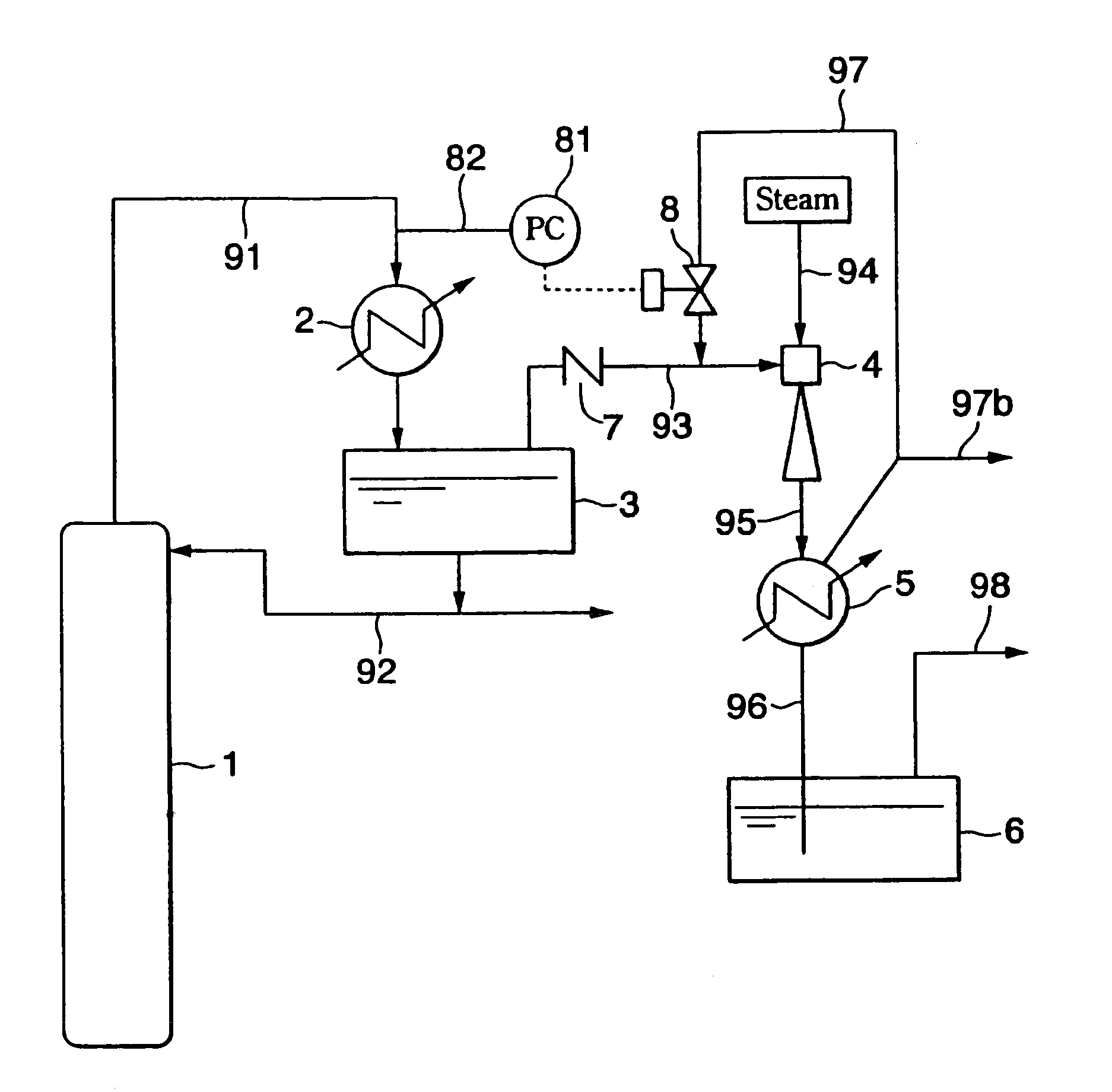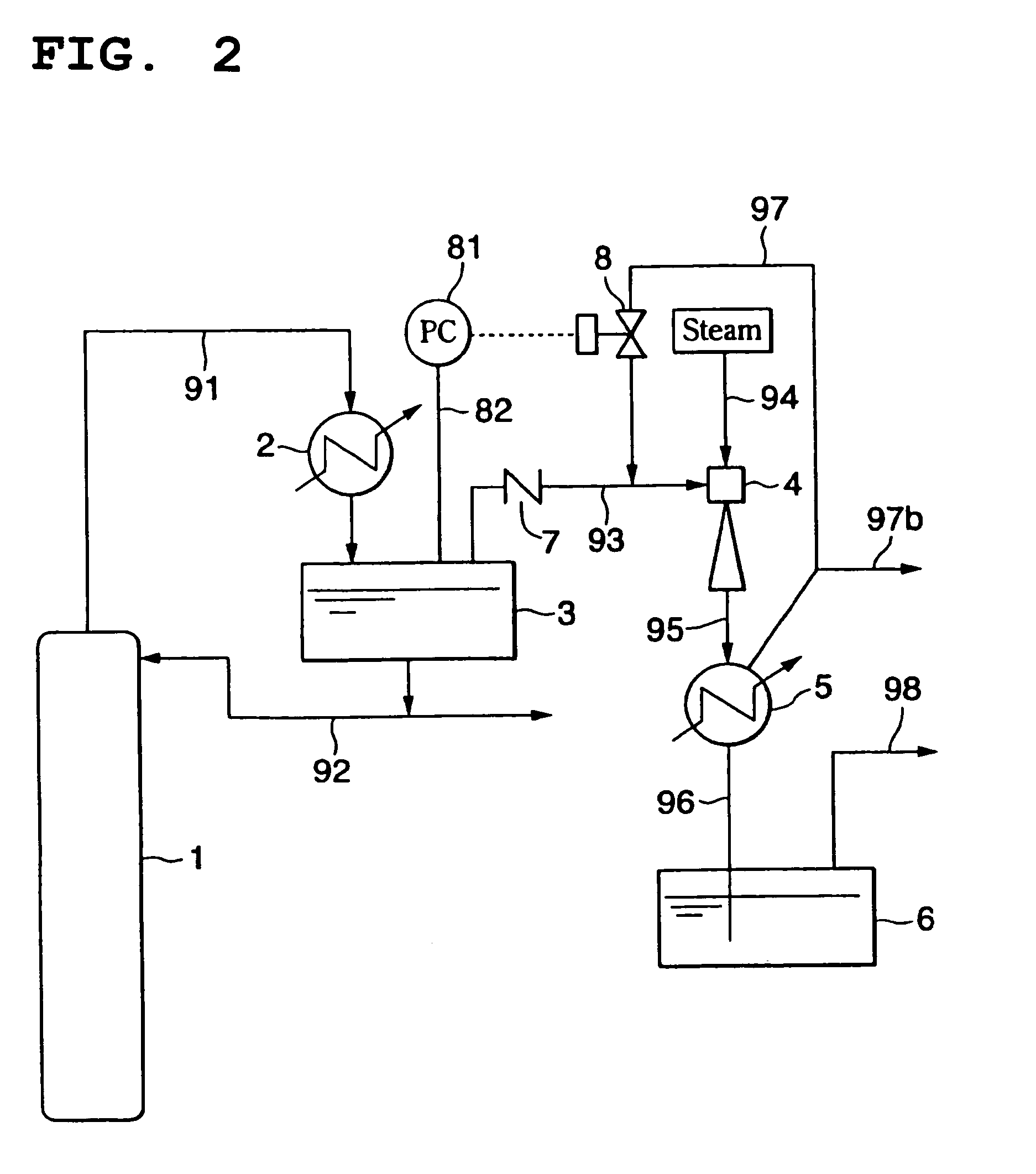Distillation apparatus for readily polymerizable compound
a technology of readily polymerizable compounds and distillation apparatuses, which is applied in the preparation of carboxylic compounds, vacuum distillation separation, separation processes, etc., can solve the problems of increased instrument size, increased non-uniformity within the column, and possible serious plugging, so as to prevent plugging in the reboiler. , the effect of preventing the possibility of serious plugging
- Summary
- Abstract
- Description
- Claims
- Application Information
AI Technical Summary
Benefits of technology
Problems solved by technology
Method used
Image
Examples
referential example 1
[0148]Decomposition reaction of a high-boiling liquid was carried out using the decomposition reaction apparatus of FIG. 8.
[0149]As the decomposition reaction apparatus, the pipe sizes a and b of the nozzles 102 and 103 are 155.2 mm (6B size), respectively, and (a / b) is equal to 1. A conduit 141 has a pipe size of 106.3 mm (4B size). The decomposition reactor has a column diameter of 1,000 mm and a column length of 2,800 mm and is made of Hastelloy C.
[0150]The high-boiling liquid had a formulation consisting of 21% by weight of butyl acrylate, 65% by weight of butyl β-butoxypropionate, 4% by weight of butyl acryloyloxypropionate, 2% by weight of butyl β-hydroxypropionate, 3% by weight of hydroquinone, 2% by weight of methoxyquinone, and 3% by weight of others and was fed at a rate of 580 kg / h.
[0151]As the reaction conditions, the decomposition reaction was carried out under a reaction pressure of 100 kPa at a decomposition temperature of 190° C. for a residence time of one hour whil...
referential example 2
[0160]In the distillation apparatus shown in FIG. 7, distillation of crude acrylic acid was carried out using a distillation column made of stainless steel (SUS316) and having an inner diameter of 1,100 mm and a length of 20,000 mm, and having 21 perforated trays (dual trays) set up therein. The pipe sizes of the discharge nozzle 102 and the introduction nozzle 103 were 155.2 mm (6B size), respectively, and a pump was provided on the way of the conduit 104. The conduit 104 has the same size as in the introduction nozzle 103. As the crude acrylic monomer, a mixture containing 98.5% by weight of acrylic acid, 0.3% by weight of maleic acid, and 0.3% by weight of an acrylic acid dimer was fed at a rate of 1,300 kg / h at 90° C.
[0161]Also, a solution of acrylic acid having 8% by weight of methoquinone dissolved therein and a solution of acrylic acid having 1% by weight of phenothiazine dissolved therein were fed at a rate of 34 kg / h and 31 kg / h, respectively from the polymerization inhibit...
referential example 3
[0166]The purification method of an acrylic acid solution was carried out in the following manner using the distillation column shown in FIG. 12.
[0167]Propylene was mixed with air and an inert gas consisting of water, nitrogen and carbon dioxide, and the propylene was reacted with molecular oxygen in the presence of a molybdenum oxide based solid catalyst in a first reaction zone to obtain acrolein. Subsequently, acrolein was reacted with molecular oxygen in the presence of a molybdenum oxide based solid catalyst in a second reaction zone to obtain a reaction gas containing an acrylic acid. Further, the reaction gas was collected with an acetic acid aqueous solution to obtain an acrylic acid aqueous solution. The resulting solution was subjected to distillation and purification to obtain a crude acrylic acid solution containing. 97% by weight of acrylic acid, 2.3% by weight of an acrylic acid dimer, and 0.4% by weight of maleic acid.
[0168]A distillation column as a standard has a co...
PUM
| Property | Measurement | Unit |
|---|---|---|
| diameter | aaaaa | aaaaa |
| diameter | aaaaa | aaaaa |
| angle | aaaaa | aaaaa |
Abstract
Description
Claims
Application Information
 Login to View More
Login to View More - R&D
- Intellectual Property
- Life Sciences
- Materials
- Tech Scout
- Unparalleled Data Quality
- Higher Quality Content
- 60% Fewer Hallucinations
Browse by: Latest US Patents, China's latest patents, Technical Efficacy Thesaurus, Application Domain, Technology Topic, Popular Technical Reports.
© 2025 PatSnap. All rights reserved.Legal|Privacy policy|Modern Slavery Act Transparency Statement|Sitemap|About US| Contact US: help@patsnap.com



